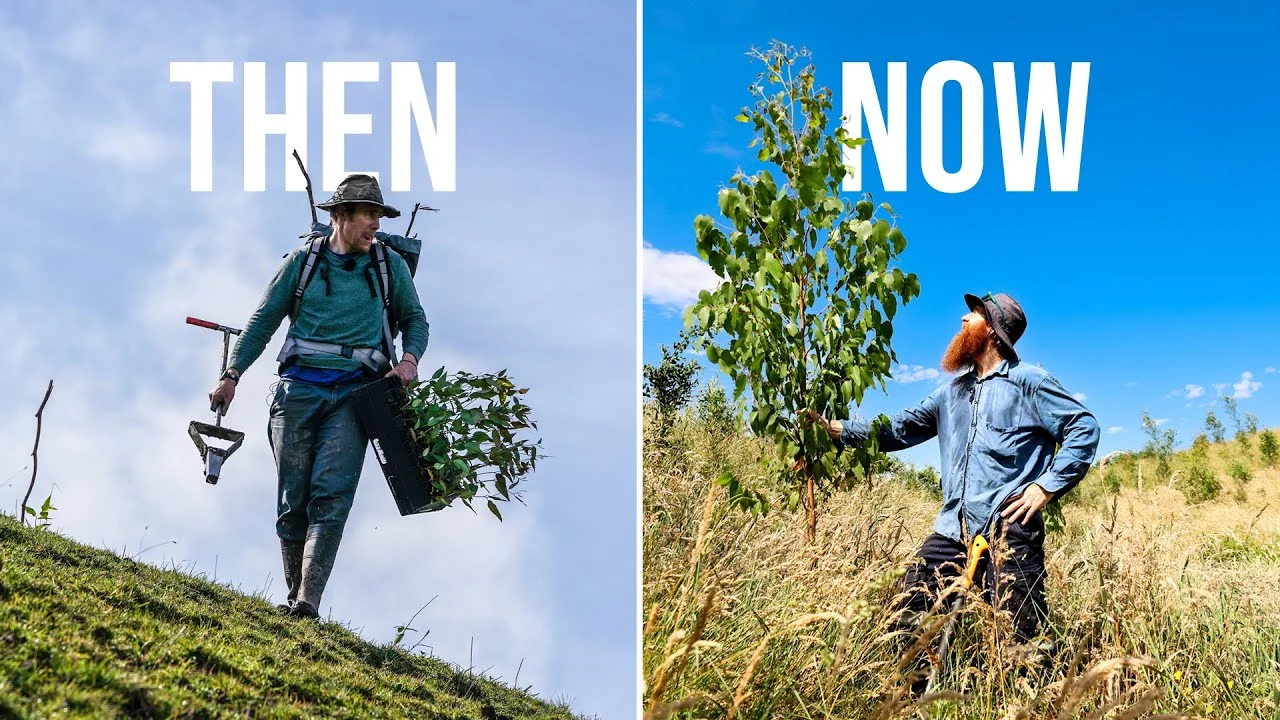39
I planted a forest two years ago
vid.puffyan.usFOREST UPDATE 2023: In August of 2021 I loaded up my old ute and old trailer with 1440 trees, bundles of long sticks, a hand of bananas, pogo-stick-planter, dirty swag, slippery tin of sunscreen and a pair of bespoke gumboots lined with running innersoles. My aim was to plant a tree a minute for 24 hours. I did it, just, plodding away with the final trays of trees as if I was wounded. In the film ‘A tree a minute’ my final text said ‘I’ll make a follow up film in two years’. So here I am, as promised, revisiting the small 2.5 acre plot on my good friends block to see how this old creek, once cleared, is getting on as a newly fledged patch of forest.
-
Produced and Directed by
BEAU MILES
Produced and Edited by
MITCH DRUMMOND
Final Sound Mix
JAMES DOBSON
Goodonya
HEATH STRATING for keeping the cows out and local critters for not being too brutal with your animal instincts.
PATRICK QUAY for photos.
CHRIS ORD for original footage.
-
For more Beauisms click here: https://linktr.ee/beauisms
Watch the original planting: https://youtu.be/AbA-hoIuHM4?si=lXwMfl1tLx4Iv--_



Yeah I agree with all that, I just expected way worse outcome with just popping the trees in the ground in a rushed manner and then leaving for 2 years. In my area you would be lucky if a single tree made it from that. I’ve seen sites have much lower survival even with considerable follow up care.
At my old org we usually saw about 70-80% survival after two years with some level of care. Admittedly that’s in an urban area where a lot more things can go wrong, and most of the tree care was done by poorly trained property owners, so not exactly comparable to your type of project.
Environmental conditions (rainfall) will have a massive impact on survival rates here, so much so it blows my mind that the entire industry doesn’t mobilise around the rain systems like La Nina and Indian dipole.
You can lose species (including the massive nursery effort/footprint) and increase replanting in the dry or just work around the rain with some light maintenance. I think the busywork keeps planting going each year rather than rapid gluts of planting around conditions. It’s a waste of resources but it is what it is. We have just had record dry conditions and high temps and our company did quite a number of plantings because “grants need to be acquitted”. It’s so dumb. Planting into dust is demoralising.
For reference, my planting since the damaging floods is at 98% survival. The floods removing a significant amount but it’s still only about 4% at planting completion. At the time, it was like 85% of 100 plants.
At least in my area precipitation is not predictable enough to rely on that way. We try to time our plantings with the rainy season but predicting which year will be wetter if dryer than average is more or less impossible. Last year was expected to be dry but it was very wet. This year is projected to be wet but so far has been dry. Long range models aren’t good enough to stake your project success on.
Plus, as you say, it would be difficult to maintain professional staff around working only once every few years. Such a system would be totally lacking in expertise and would also create much inferior working conditions. If the rains don’t come, you need to irrigate more. That’s just how it is and I don’t see a way around it.
I’m not sure I understand the breakdown of numbers there. Are you counting replants in your survival there? I would not include those because they are of a different age cohort unless planted shortly after the original trees. My number doesn’t include replacements.
I am but one person with a full time job and a “charity” business I run on the side. We have about 4 months of wet weather to plant in on a good year.
The planting has 3000 plants total, 95% grown by me in nursery. I’m not speedspading as I have to hoe out grass as I go (chemical free site) so I tend to plant approx 50-100 per afternoon I devote to it. 30-60 afternoons say. In one weekend, a flood ripped through and ripped out some oldish ones and a lot of young but I wasn’t finished the site so I just replaced and kept working.
If I exclude that event, I can only visualise a few deaths across the entire planting. Failure to thrives aren’t included. That’s with zero watering but watering in at planting time.
Here is a tree that is 12 months old but the earliest part of site is now 2 years old. The youngest is but a few weeks:
At work we did a planting that had 2 deaths out of 2000; wet years it’s easy to keep the numbers high, you have to fuck it up to do otherwise.